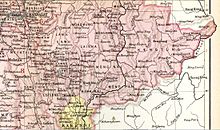| Kenghkam State | |||||||||
|---|---|---|---|---|---|---|---|---|---|
| State of the Shan States | |||||||||
| 1811–1882 | |||||||||
 Keng Hkam State in an Imperial Gazetteer of India map | |||||||||
| Capital | Keng Hkam | ||||||||
| Area | |||||||||
• 1901 | 432.5 km2 (167.0 sq mi) | ||||||||
| Population | |||||||||
• 1901 | 5,458 | ||||||||
| History | |||||||||
• State founded | 1811 | ||||||||
• Annexed by Mongnai State | 1882 | ||||||||
| |||||||||
Kenghkam or Keng Hkam (also known as Kyaingkan) was a Shan state in what is today Burma. The capital was the town of Keng Hkam, located by the Nam Pang River. [1]